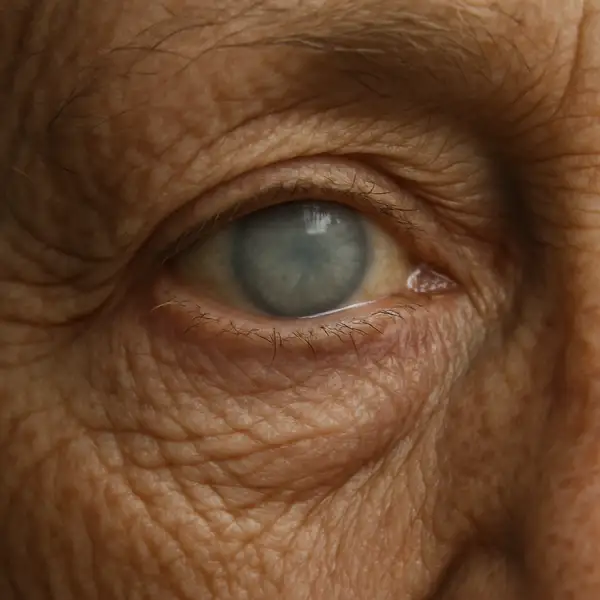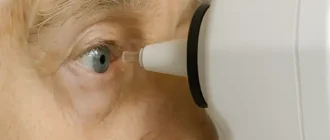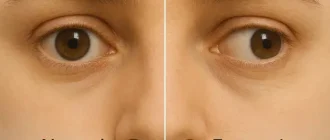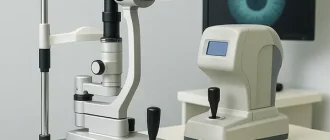Most people don’t think about their eye health—until those little changes in vision start to get in the way of daily life. Maybe reading road signs at dusk is getting harder, or you need to turn on an extra lamp just to see the fine print on a package.
Percentage of U.S. Adults Over 45 with Presbyopia
This chart illustrates the estimated prevalence of presbyopia among U.S. adults aged 45 and older. The percentage increases with age, affecting nearly 9 in 10 people aged 65 and above. Data from CDC, NVISION Centers, Medscape, and other reputable sources.
For millions of adults, eye deterioration with age is a normal part of life, but knowing what’s behind these changes and how to spot them early is the key to preserving sharp vision for as long as possible. From blurred vision to glare, and from cataracts to macular degeneration, understanding age-related eye conditions is the first step to taking control of your eye health.
What Are the Main Causes of Age-Related Eye Deterioration?
First, let’s call out the usual suspects. Most age-related eye changes are due to a natural, gradual breakdown of eye structures. But what does that actually mean in real life? Here are the main culprits—with relatable analogies and what it might feel like for you:
- Presbyopia: The eye lens stiffens, making it harder to focus on close objects. Imagine your camera’s autofocus getting stuck—suddenly, holding your phone at arm’s length is the only way to read a text message. This often sneaks up after age 40, especially in low light.
- Cataracts: The lens clouds over time, blurring vision. Think of looking through a frosty window or a fogged-up windshield. Colors seem faded, and everything gets a bit “hazy.” You might notice headlights have big halos at night, or reading gets tougher even with your regular glasses.
- Macular degeneration: The macula (the part of the retina responsible for sharp, central vision) breaks down, causing central vision loss. It’s like putting a smudge right in the center of your favorite photograph—faces and words in the middle of your vision blur or disappear, while side vision often stays normal.
- Glaucoma: Increased eye pressure damages the optic nerve. Picture a slow leak in a garden hose—pressure quietly builds up until the hose gets damaged. Most people don’t notice symptoms at first, but over years, side vision shrinks. By the time you notice, it’s like looking through a tunnel.
- Dry eye syndrome: Tear production decreases, leading to discomfort and blurry vision. It can feel like there’s sand in your eyes, or your vision is blurry and clears up when you blink. Dryness is often worse late in the day, after lots of screen time, or in air-conditioned rooms.
AMD Prevalence by Age Group in U.S. (2019)
This chart compares the prevalence of age-related macular degeneration (AMD) among U.S. adults by age group in 2019. Rates increase dramatically with age, with nearly half of adults 85 and older affected. Data from CDC, PMC, and DelveInsight.
Other factors also stack the odds against your eyes as you age: genetics (if mom or dad had vision issues, keep an eye out), chronic exposure to sunlight (UV rays speed up damage—wear those shades!), long-term use of certain medications, and health conditions like diabetes [source].

How Common Is Age-Related Eye Deterioration?
Don’t worry, you’re in good company. According to the CDC, approximately 12 million Americans aged 40 and older have some type of vision impairment. Roughly 1 in 3 people will have some vision-reducing eye disease by age 65 [source]. The numbers are even higher in populations over 75.
| Age Group | Prevalence of Vision Impairment (%) |
|---|---|
| 40–64 | 6 |
| 65–74 | 12 |
| 75+ | 20 |
What Are the Symptoms of Aging Eyes?
The red flags aren’t always flashing neon. Here are the most common symptoms, what they feel like, and how you can recognize when it’s time to see a specialist:
- Blurred or Cloudy Vision
- What it feels like: Objects lose their sharpness and appear hazy or out of focus, especially when reading or looking at distant signs. This may come and go at first, then become more constant. If blurriness lasts more than a few days or gets worse over time, it’s worth checking out.
- Difficulty Seeing at Night or in Low Light
- What it feels like: Driving after sunset or moving around a dim room becomes tricky. Some people notice halos or glare around lights, and it might take longer for eyes to adjust from light to dark. If you find yourself avoiding nighttime driving, this is a classic warning sign.
- Frequent Changes in Glasses or Contact Lens Prescriptions
- What it feels like: You’re making extra trips to the optometrist because your vision keeps changing every few months. This can be frustrating and is often an early clue for cataracts or diabetes-related changes. If you need new prescriptions more than once a year, take note.
- Colors Appearing Faded
- What it feels like: Colors seem dull, less vibrant, or washed out. Whites may look yellowish or brownish. This typically develops gradually and can be more noticeable in daylight.
- Increased Sensitivity to Glare
- What it feels like: Bright sunlight, oncoming headlights, or reflective surfaces create intense discomfort or reduce your ability to see. This is especially noticeable when driving during the day or at night.
- Trouble Reading Small Print (the “Long-Arm” Syndrome)
- What it feels like: You’re holding books, menus, or your phone at arm’s length just to focus. If you need brighter light to read or squint often, you’re not alone—this is presbyopia, and it’s basically a rite of passage after 40.
- Eye Pain or Pressure (especially with glaucoma)
- What it feels like: A dull ache, throbbing, or sensation of fullness around or behind the eye, sometimes with headaches or nausea. Pain is not normal and may come on suddenly or last for several days. If you have ongoing eye pain, see a doctor ASAP.
Helpful tip: Some symptoms (like glare or night vision problems) are worse in certain lighting conditions or may fluctuate during the day. If symptoms last more than a week, become progressively worse, or impact daily activities, it’s definitely time for a professional checkup.
When symptoms creep up gradually, it’s easy to shrug them off as “just getting older,” but prompt action is key [source].
Modern Diagnostic Methods: How Is Age-Related Eye Deterioration Detected?
Welcome to the era of high-tech eye care. Modern diagnostics offer much more than that classic “which is better, one or two?” routine. Here’s what’s in the toolbox:
1. Optical Coherence Tomography (OCT)
- How it works: Uses light waves to create detailed images of the retina and optic nerve.
- Accuracy: 9/10
- Average cost: $100–$300 (USD) / €90–€270 per scan
2. Fundus Photography
- How it works: High-resolution photos of the retina reveal changes from macular degeneration, diabetes, and more.
- Accuracy: 8/10
- Average cost: $75–$200 (USD) / €68–€180
3. Visual Field Testing
- How it works: Maps side vision and detects glaucoma damage.
- Accuracy: 7/10
- Average cost: $50–$150 (USD) / €45–€135
4. Tonometry
- How it works: Measures eye pressure to screen for glaucoma. Now, most clinics use “puff of air” or contact devices.
- Accuracy: 8/10
- Average cost: $30–$70 (USD) / €27–€63
5. Advanced AI Analysis
- How it works: Platforms like IDx-DR (approved by the FDA) analyze retinal images to detect diabetic retinopathy with high accuracy.
- Accuracy: 9/10
- Average cost: Included with retinal imaging or about $50 (USD) / €45 extra
These technologies make eye exams way more insightful than in the past—and let’s face it, way cooler [source].
Refractive Errors in U.S. Adults Over 40
This chart shows the prevalence of common refractive errors among U.S. adults aged 40 and older. Astigmatism is the most common, affecting about a third of adults, while myopia and hyperopia are also significant. Data from CDC, NVISION Centers, and Verywell Health.
Medical Case Studies: Stories from Across the USA
Case 1: 57-year-old woman, Atlanta, GA: After noticing trouble driving at night, she was diagnosed with early cataracts and mild macular degeneration. She switched to special anti-glare lenses and began using AREDS2 supplements, slowing further vision loss.
Case 2: 69-year-old man, Phoenix, AZ: Routine screening caught high eye pressure before he had symptoms. Early glaucoma was confirmed with OCT, and treatment with Latanoprost drops kept his vision stable.
Case 3: 81-year-old man, Seattle, WA: Gradual blurriness and faded colors led to a diagnosis of advanced cataracts. He underwent femtosecond laser-assisted cataract surgery, restoring sharp vision in both eyes [source].
What Are the Latest Treatment Options?
The world of eye care has seriously leveled up. Treatments today go way beyond “get new glasses.” Here’s a closer look at the latest options—what they are, how they work, effectiveness, cost, and what patients need to know:
Cataract Surgery
What is it? Outpatient procedure where the eye’s cloudy lens is removed and replaced with a clear, artificial lens (IOL). Technologies include ultrasound (phacoemulsification) and femtosecond laser-assisted surgery (LenSx, Catalys).
How is it performed? After numbing the eye, the surgeon makes a tiny incision (less than 0.12 in / 3 mm). The cloudy lens is broken up and removed, then the IOL is inserted. Laser systems make the procedure more precise and speed recovery.
Effectiveness: Success rate is over 98%. Most patients experience significant, lasting vision improvement.
Cost: $3,500–$5,000 (USD) / €3,200–€4,500 per eye (premium IOLs can be higher). Basic surgery may cost less if done with standard lenses.
Extra info: Premium lenses can reduce need for glasses, correcting astigmatism or presbyopia. Recovery is typically quick, with vision returning in a few days.
Anti-VEGF Injections
What is it? Medications like Eylea (aflibercept), Lucentis (ranibizumab), and Avastin (bevacizumab) injected into the eye to treat wet macular degeneration and diabetic retinopathy.
How is it performed? The eye is numbed and a fine needle delivers the medicine into the vitreous (gel inside the eye). Injections are repeated every 4–12 weeks.
Effectiveness: Reduces vision loss risk by up to 90% for eligible patients and may improve sight in 30%–40% of cases.
Cost: $1,800–$2,400 (USD) / €1,650–€2,200 per injection; some generics may cost less.
Extra info: Patients may feel slight pressure but little pain. Most resume daily activities the same or next day.
Minimally Invasive Glaucoma Surgeries (MIGS)
What is it? Tiny implants—like iStent, Hydrus Microstent, or Xen Gel Stent—placed inside the eye to reduce pressure for glaucoma patients.
How is it performed? Surgeons insert micro-stents through very small incisions, usually combined with cataract surgery. Takes under 30 minutes.
Effectiveness: Lowers eye pressure by 20–40% in most cases; reduces need for drops.
Cost: $2,500–$4,500 (USD) / €2,300–€4,100 per procedure, often combined with cataract surgery.
Extra info: Less risk and downtime than traditional glaucoma surgery. Vision improves quickly for most.
Prescription Eye Drops
What is it? Medications such as Latanoprost, Timolol, Dorzolamide, and others are used to lower eye pressure in glaucoma or treat dry eyes.
How are they used? Drops are instilled daily, sometimes several times a day depending on the medication and doctor’s advice.
Effectiveness: When used regularly, can reduce intraocular pressure by up to 30%. Many patients need lifelong use.
Cost: $25–$120 (USD) / €23–€110 per bottle (monthly supply).
Extra info: Modern drops are generally well-tolerated but may sometimes cause stinging, redness, or irritation.
Specialty Contacts and Lenses
What is it? Blue light-blocking lenses, anti-glare coatings, and multifocal or toric contact lenses for presbyopia and astigmatism.
How are they used? Customized to the patient’s needs, these lenses can address age-related focusing problems and digital eye strain.
Effectiveness: Can significantly improve comfort, night driving, reading, and screen use.
Cost: $100–$400 (USD) / €90–€360 for specialized glasses; contacts $40–$150 (USD) / €36–€135 per box.
Extra info: Blue light-blocking and anti-glare options are especially popular among people working with screens all day.
AREDS2 Supplements
What is it? Vitamins and minerals (vitamin C, E, zinc, copper, lutein, zeaxanthin) clinically proven to slow the progression of age-related macular degeneration (AMD).
How are they used? Usually taken as daily capsules or tablets.
Effectiveness: Slows AMD progression by up to 25% in patients with intermediate/advanced stages.
Cost: $25–$40 (USD) / €23–€36 for a month’s supply.
Extra info: AREDS2 does not cure AMD but can help preserve existing vision for many people.
No more one-size-fits-all—today’s treatments are truly customized [source].
How Can You Protect Your Eyes as You Age?
Here are some “no kidding” expert-backed steps to help keep your eyes sharp:
- Get a comprehensive eye exam every 1–2 years after age 40
- Wear sunglasses with 100% UV protection (style points optional!)
- Manage blood sugar and blood pressure
- Eat a diet rich in leafy greens, fish, and colorful veggies
- Use lubricating eye drops if you have dry eyes
- Take breaks from screens—your eyes will thank you [source]
Editorial Advice
As Reyus Mammadli, medical consultant, recommends: “Don’t wait for dramatic vision changes to schedule an eye exam. Early diagnosis is everything—modern treatments are most effective when problems are caught early. Protect your eyes the same way you’d protect any other part of your health. After all, you only get one pair!”
The editorial team also suggests discussing any vision changes with your healthcare provider promptly, and asking about the latest technologies in eye diagnostics and treatment during your checkups.





